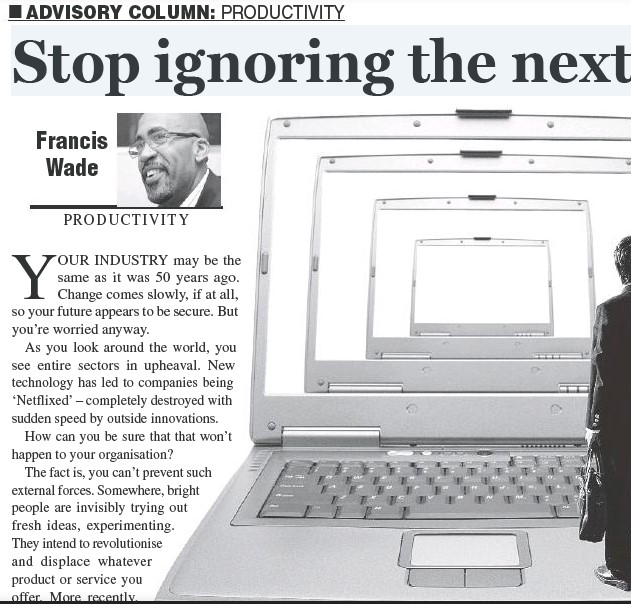Your industry may be the same as it was 50 years ago. Change comes slowly, if at all, so your future appears to be secure. But you’re worried, anyway. As you look around the world you see entire sectors in upheaval. New technology has led to companies being “Netflixed” – completely destroyed with sudden speed by outside innovations.
How can you be sure that won’t happen to your organization?
The fact is, you can’t prevent such external forces. Somewhere, bright people are invisibly trying out fresh ideas, experimenting. They intend to revolutionize and displace whatever product or service you offer. More recently, COVID has shown just how small the earth is, and how vulnerable we are in the Caribbean. Your company isn’t safe, and the barriers that kept competition away are falling faster each day.
In the face of increased risk, how do you respond? Some are fatalistic, believing that you can’t stop a hurricane, epidemic or technology from upsetting the best -made plans. However, if your organization intends to do more than put its head in the sand, here are some steps to follow.
- Plan Scenarios
If you can divine the small beginnings of a disruptive technology, congratulations. You’re halfway there. If you can’t, start looking by scouring the trade press.
Also tune into what younger staff are seeing and saying. They could be closer to determining the outlook than you are. Why? They’ll be the ones who will deal with it. In fact, if they sense a disruption, expect them to test your leadership team. “Do these executives even have a clue?” they may ask. When they conclude the worst, they’ll leave.
Use these inklings to capture future scenarios for your organization. Go out at least 20 years and see what happens when different possibilities play out. For the ones which are most likely, craft a single preferred outcome. Then, backcast to this year to determine what your short-term actions should be.
But sometimes this won’t work.
I have seen teams realize: “The company has no future.” Like the old photo film industry, they realized that the tides are turning for good, and they need an escape plan. Working harder would just deepen their dependency, as it did for Kodak. Today, its rival Fuji is thriving in entirely new lines of business while Kodak is defunct.
- Get the Timing Right
Another lesson which emerged from the Fuji vs. Kodak battle is the fact that the latter invested in bad bets.
Some believe Kodak didn’t foresee the advent of digital photography, but a closer look at the record shows otherwise. They were one of the first to predict that the technology would replace their more profitable film business.
However, their response to the threat was mistaken. They invested in digital kiosks around the world, mostly in shopping centres. Their belief? Customers wanted to make prints in a convenient location.
They were correct, but they missed the growth of desktop computing. Customers shifted to managing their photos at home, powered by computers and printers built by HP, Compaq and Apple.
Unfortunately, Kodak’s timing was wrong. Their strategy failed.
The best solution to this problem? Bring in a wide range of team members to craft your plans. This task is too difficult to be left to a single individual, even if he is the company founder and a certified genius.
- Focus on Todays’ Implementation
Even if you capture the perfect plan for the next disruption, it’s easy to be swallowed up by today’s emergency. No surprise: your organization isn’t designed to adopt unfamiliar ways of doing things.
For example, the day after the retreat, the easiest thing someone can do is go back to what they were doing before. After all, their calendar looks the same, email messages haven’t gone away and the same meetings are scheduled.
Consequently, internal processes don’t change. Projects fail to be launched. Strategic initiatives never leave the retreat.
It takes incredible energy to bring about such a transformation and Caribbean people won’t switch if they don’t know why they must. In other words, just being told to do something different will not work.
Instead, company leaders should win over hearts and minds. They need to inspire staff to see the reasons why change is imperative and urgent. But this is no one-time task: it requires constant reinforcement and performance management.
In summary, the real villain isn’t innovative technology but your company’s ineffective response. Delay these three actions and you’ll probably fall behind, never able to catch up.
The upside is that these steps are within your control and will prepare you for the introduction of a new technology that threatens to “Netflix” your company into oblivion.
Francis Wade is the host of the Caribbean Strategy Conference on June 23-25. To search his prior columns on productivity, strategy, engagement and business processes, send email to columns@fwconsulting.com.

